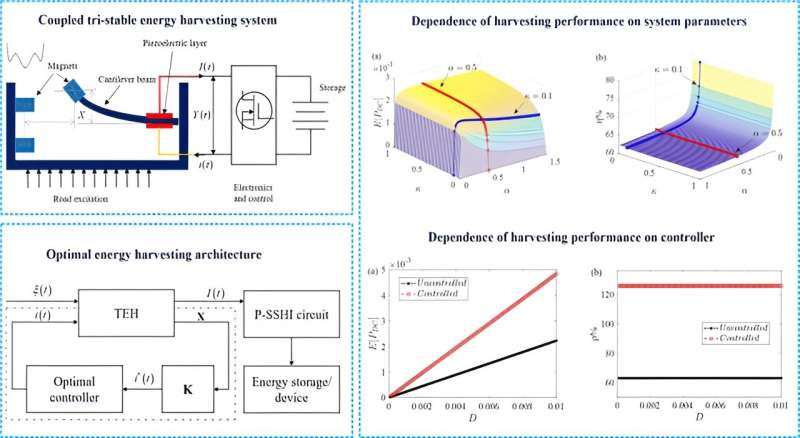
The energy demands of today's ubiquitous small electronic devices—including sensors, data transmitters, medical implants and 'wearable' consumer products such as Fitbits—can no longer be met by chemical batteries alone. This gap can be filled by energy harvesters, which turn ordinary, ambient vibrational energy into electrical energy.
The most efficient types of harvester are tri-stable energy harvesters, which can convert even low-frequency random vibrations into alternating current (AC) and thence into direct current (DC).
Tingting Zhang and Yanfei Jin from Beijing Institute of Technology in China have now investigated how the properties of these systems can be altered to optimize the power output; their findings are published in the European Physical Journal B.
Tri-stable energy harvesters are examples of non-linear energy harvesters, which can use a wider bandwidth of vibrations than the earlier, linear ones. They convert mechanical energy from random vibrations in the environment directly into AC and then, via a rectifier circuit, into the DC that powers electronic devices.
"Control methods can be used to enhance the energy harvesting ability of this system," says Jin. "We optimized the control of a tri-stable energy harvester under a parallel synchronized switching system, or P-SSHI, to obtain the most efficient DC power output from colored noise."
Colored noise is defined as a random vibrational signal in which different vibrational frequencies are present with varying intensities. Jin and Zhang used it for their experiments because it resembles the random vibrations of a natural environment.
"We showed that an energy harvester that is controlled in this way is more efficient than one without control, and our theoretical calculations were well supported by Monte Carlo simulations," adds Jin. "We now hope to optimize the design of the management circuit, which is crucial for the energy supply of these small, low-power electronic devices."
More information: Tingting Zhang et al, Stochastic optimal control of a tri-stable energy harvester with the P-SSHI circuit under colored noise, The European Physical Journal B (2024). DOI: 10.1140/epjb/s10051-024-00650-2
Citation: Harvesting vibrational energy from 'colored noise' (2024, April 18) retrieved 18 April 2024 from https://techxplore.com/news/2024-04-harvesting-vibrational-energy-noise.html
This document is subject to copyright. Apart from any fair dealing for the purpose of private study or research, no part may be reproduced without the written permission. The content is provided for information purposes only.
